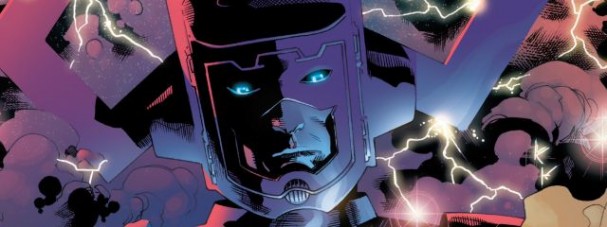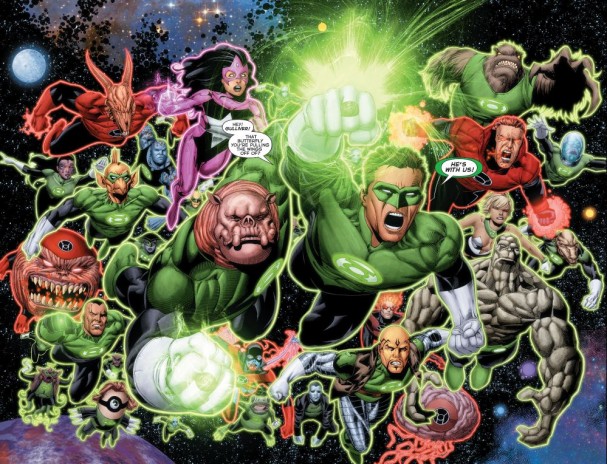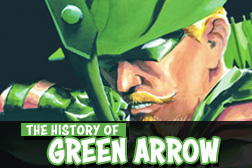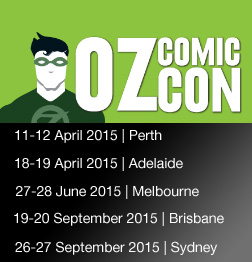Don’t have time for long reviews of comics? Then check out Graphic Bits: bite sized chunks of comic book goodness designed to get behind the panels and into your hearts.
This week (30 October 2013) it’s the beginning of the end in Ultimate Comics: Cataclysm #0.1, and maybe the other way around in Infinity #5. Another ending of sorts can be found in X-Men: Battle of the Atom #2, a new beginning in Damian: Son of Batman #1 and Green Lantern Annual #2 shows them all how a crossover should be done. There’s also Edgar Allen Poe’s The Raven and the Red Death (One Shot) just in time for Halloween, DC’s Forever Evil: A.R.G.U.S. #1 and Saga #15, which stands alone as a totem of awesome. This is Graphic Bits.
Our featured review this week is, of course, the wonderful Neil Gaiman book The Sandman: Overture #1. Check it out.
Ultimate Comics: Cataclysm #0.1 – Marvel, Joshua Hale Fialkov (writer), Mico Suayan, Mirco Pierfederici, Leonard Kirk, Nolan Woodard (artists).
Rating: 6/10
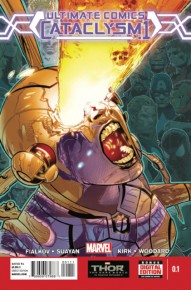 While it could be argued that everything after (and including) Age of Ultron has been a prelude to Cataclysm, not least of which is the Hunger mini-series, this marks the next “beginning of the end” for the Ultimate Marvel Universe. Cataclysm #0.1 serves as a bridge between Hunger and the main Cataclysm event, and mostly concentrates on Ultimate Vision confronting the Marvel 616 Galactus. If you are coming from the Ultimate point of view, there is going to be a great deal to get out of this, potentially wrapping up a few character threads, with a big heroic moment. For a broader audience (who are presumably the target for this issue), it is less appealing, with the concept of Galactus getting ready to devour the Ultimate Universe being fairly clear and not requiring this “primer” issue. Indeed, without the corresponding background, Ultimate Vision is a bit of a cold fish, although this is partly the point of the narrative. Art duties are handled by three different artists, but to their credit it’s really hard to tell where the art shifts are made. The credits tell us where the seams are, and Leonard Kirk’s pin-up of Galactus dwarfing the defiant Ultimate Vision in space is definitely one of the highlights of the book. Unless you are an Ultimate completist, give this one a miss but definitely tune in for the main event: it promises to be epic.
While it could be argued that everything after (and including) Age of Ultron has been a prelude to Cataclysm, not least of which is the Hunger mini-series, this marks the next “beginning of the end” for the Ultimate Marvel Universe. Cataclysm #0.1 serves as a bridge between Hunger and the main Cataclysm event, and mostly concentrates on Ultimate Vision confronting the Marvel 616 Galactus. If you are coming from the Ultimate point of view, there is going to be a great deal to get out of this, potentially wrapping up a few character threads, with a big heroic moment. For a broader audience (who are presumably the target for this issue), it is less appealing, with the concept of Galactus getting ready to devour the Ultimate Universe being fairly clear and not requiring this “primer” issue. Indeed, without the corresponding background, Ultimate Vision is a bit of a cold fish, although this is partly the point of the narrative. Art duties are handled by three different artists, but to their credit it’s really hard to tell where the art shifts are made. The credits tell us where the seams are, and Leonard Kirk’s pin-up of Galactus dwarfing the defiant Ultimate Vision in space is definitely one of the highlights of the book. Unless you are an Ultimate completist, give this one a miss but definitely tune in for the main event: it promises to be epic.
Damian: Son of Batman #1 (of 4) – DC Comics, Andy Kubert (writer/artist), Brad Anderson (colourist).
Rating: 5/10
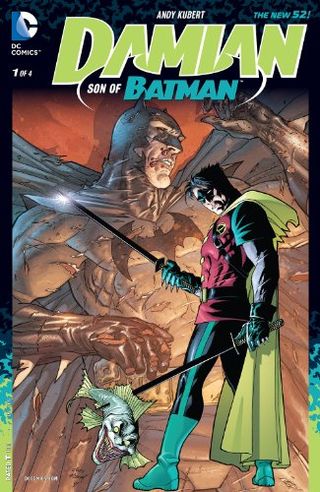 Grant Morrison dropped at least two major bombshells into the DCU during his tenure on his various Bat-books. Not only did he sexualise the Bat by revealing he had a son with Talia al Ghul, but he abruptly killed him off in Batman Incorporated #8. This death, Morrison maintains, was engineered from the beginning, and it sent shockwaves across the entire Batman line-up. Here Andy Kubert resurrects him in the nebulous future of the New 52, where it’s the apparent death of Batman that sends a returned Damian Wayne on a killing rampage across the rogues gallery. If it weren’t for ‘The New 52’ plastered on the cover, this has all the markings of an Elseworlds story, one with convenient plot turns, such as a blog trail that leads Damian to every villain in the city. There’s also an inexplicably returned Talia, so the continuity is very questionable. The art is of a much higher standard, although the expression on Robin’s face in the first page (“Holy crap–!”) is a little too close to parody. “Berserker Robin” is all kinds of cool, and the way the light plays off a crucifix in a church scene is positively gorgeous. A final page twist makes this something a little more interesting than the premise that led there, but unless DC have got something sneaky up their sleeves, all this can hope to do is cheapen the decade of stories that Morrison built to lead us here.
Grant Morrison dropped at least two major bombshells into the DCU during his tenure on his various Bat-books. Not only did he sexualise the Bat by revealing he had a son with Talia al Ghul, but he abruptly killed him off in Batman Incorporated #8. This death, Morrison maintains, was engineered from the beginning, and it sent shockwaves across the entire Batman line-up. Here Andy Kubert resurrects him in the nebulous future of the New 52, where it’s the apparent death of Batman that sends a returned Damian Wayne on a killing rampage across the rogues gallery. If it weren’t for ‘The New 52’ plastered on the cover, this has all the markings of an Elseworlds story, one with convenient plot turns, such as a blog trail that leads Damian to every villain in the city. There’s also an inexplicably returned Talia, so the continuity is very questionable. The art is of a much higher standard, although the expression on Robin’s face in the first page (“Holy crap–!”) is a little too close to parody. “Berserker Robin” is all kinds of cool, and the way the light plays off a crucifix in a church scene is positively gorgeous. A final page twist makes this something a little more interesting than the premise that led there, but unless DC have got something sneaky up their sleeves, all this can hope to do is cheapen the decade of stories that Morrison built to lead us here.
Edgar Allen Poe’s The Raven and the Red Death (One Shot) – Dark Horse, Richard Corben (writer/artist). Rating: 8/10
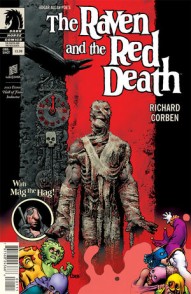 Just in time for Halloween, the magical combination of Richard Corben and Poe brings us two of the master of macabre’s most loved tales. The Raven is such a familiar story that it has almost become a parody of itself, and Corben himself had loosely adapted it back in 1974 in the pages of Creepy #67. The tone is set by Corben’s “host” Mag the Hag who remarks “The weather has put young Arnold in a melancholy mood, leading him to grimly narrate his own evening in verse.” Corben gives us his own spin on the midnight dreary, actually placing the one whom the angels name Lenore as a character in the piece. The titular Raven is a demonic thing, one Corben depicts as a ghastly grim and ancient bird. In his adaptation of The Masque of the Red Death, Corben plays up the hysteria of luxury, with a cartoonish string of buffoons celebrating while the city outside succumbs to the horrors of the Red Death. Corben wholly makes it his own world by the end of the piece, not only giving us a twist on one of Poe’s most chilling ends (“darkness and decay and the Red Death held illimitable dominion over all”) but loudly winking (is that physically possible?) at the reader while doing it.
Just in time for Halloween, the magical combination of Richard Corben and Poe brings us two of the master of macabre’s most loved tales. The Raven is such a familiar story that it has almost become a parody of itself, and Corben himself had loosely adapted it back in 1974 in the pages of Creepy #67. The tone is set by Corben’s “host” Mag the Hag who remarks “The weather has put young Arnold in a melancholy mood, leading him to grimly narrate his own evening in verse.” Corben gives us his own spin on the midnight dreary, actually placing the one whom the angels name Lenore as a character in the piece. The titular Raven is a demonic thing, one Corben depicts as a ghastly grim and ancient bird. In his adaptation of The Masque of the Red Death, Corben plays up the hysteria of luxury, with a cartoonish string of buffoons celebrating while the city outside succumbs to the horrors of the Red Death. Corben wholly makes it his own world by the end of the piece, not only giving us a twist on one of Poe’s most chilling ends (“darkness and decay and the Red Death held illimitable dominion over all”) but loudly winking (is that physically possible?) at the reader while doing it.
Forever Evil: A.R.G.U.S. #1 – DC Comics, Sterling Gates (writer), Philip Tan, Neil Edwards, Javier Pina, Jason Paz, Jay Leisten, Nathan Eyring and Romulo Fajardo Jr. (artists).
Rating: 7/10
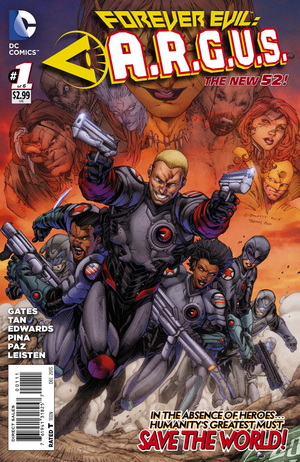 With the Justice League apparently dead, Forever Evil: A.R.G.U.S. #1 gives us a few convenient reasons as to why Trinity War survivor Steve Trevor doesn’t have a clue as to why. Partly an origin story for Trevor’s relationship with Wonder Woman, but also one of the first “Forever Evil” tie-in books to explicitly acknowledge that notions are being put in motion elsewhere in the DCU. Some of the issue feels like a retread, and falls back on the familiar trope of using touchscreens as a substitute for drama, and the forward momentum comes from Trevor’s ill-advised assault on the bad guys. Art duties are handled by a veritable army of people, but there is a kind of consistency. An abrupt shift to a dreamlike set of pages with Wonder Woman is justified by it being a flashback, although some thickish lines on a confrontation with Copperhead and Deathstroke stick out like a heavily outlined thumb. The reveal of the final page gives some hope that this series will take a turn for the better, but so far the narrative would have been better served as a Steve Trevor one-shot. Richard wrote a longer review for this issue over at Newsarama.
With the Justice League apparently dead, Forever Evil: A.R.G.U.S. #1 gives us a few convenient reasons as to why Trinity War survivor Steve Trevor doesn’t have a clue as to why. Partly an origin story for Trevor’s relationship with Wonder Woman, but also one of the first “Forever Evil” tie-in books to explicitly acknowledge that notions are being put in motion elsewhere in the DCU. Some of the issue feels like a retread, and falls back on the familiar trope of using touchscreens as a substitute for drama, and the forward momentum comes from Trevor’s ill-advised assault on the bad guys. Art duties are handled by a veritable army of people, but there is a kind of consistency. An abrupt shift to a dreamlike set of pages with Wonder Woman is justified by it being a flashback, although some thickish lines on a confrontation with Copperhead and Deathstroke stick out like a heavily outlined thumb. The reveal of the final page gives some hope that this series will take a turn for the better, but so far the narrative would have been better served as a Steve Trevor one-shot. Richard wrote a longer review for this issue over at Newsarama.
Green Lantern Annual #2 – DC Comics, Robert Venditti (writer), Sean Chen, Jon Sibal, Walden Wong, Andrew Dalhouse and Wil Quintana (artists)
Rating: 9/10
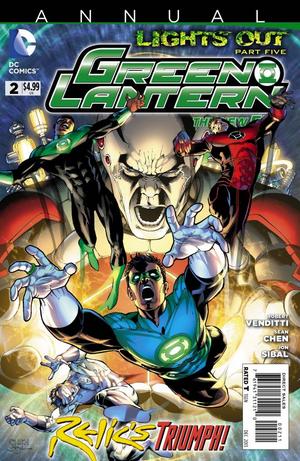 One of the unsung heroes of the New 52 has been the “Lights Out” event going on over at the Green Lantern universe. Geoff Johns may have left some big shoes to fill, but Robert Venditti began his first event almost immediately, introducing the character of Relic and threatening the very source of the light spectrum’s power. Relic has been an interesting “villain”, mostly because his motivations were of someone trying to save the universe from depleting its light, even if this exhibited itself as an aggressive act towards our heroes. Yet even as “the fate of every Green Lantern hangs in the balance”, tensions between Green Lantern Hal Jordan, Star Sapphire Carol Ferris, White Lantern Kyle Rayner and recent Red Lantern Guy Gardner exhibit themselves. Then final fight might feel somewhat rushed, but it’s an epic smack-down for the ages, with a final push that will not only have you cheering in your seats but will also have lasting consequences for Rayner in particular. Former Nova artist Sean Chen relieves Billy Tan, comfortably slipping into the cosmic world, and providing everything from close-quartered and brutal fight scenes to an impressive call to arms sequence (pictured above). “Lights Out” shows the rest of the New 52 how it is done by isolating itself from other events, being true to its own history and most importantly, tying up its plot points before pointing us in the direction of the next crossover. Richard wrote a longer review for this issue over at Newsarama.
One of the unsung heroes of the New 52 has been the “Lights Out” event going on over at the Green Lantern universe. Geoff Johns may have left some big shoes to fill, but Robert Venditti began his first event almost immediately, introducing the character of Relic and threatening the very source of the light spectrum’s power. Relic has been an interesting “villain”, mostly because his motivations were of someone trying to save the universe from depleting its light, even if this exhibited itself as an aggressive act towards our heroes. Yet even as “the fate of every Green Lantern hangs in the balance”, tensions between Green Lantern Hal Jordan, Star Sapphire Carol Ferris, White Lantern Kyle Rayner and recent Red Lantern Guy Gardner exhibit themselves. Then final fight might feel somewhat rushed, but it’s an epic smack-down for the ages, with a final push that will not only have you cheering in your seats but will also have lasting consequences for Rayner in particular. Former Nova artist Sean Chen relieves Billy Tan, comfortably slipping into the cosmic world, and providing everything from close-quartered and brutal fight scenes to an impressive call to arms sequence (pictured above). “Lights Out” shows the rest of the New 52 how it is done by isolating itself from other events, being true to its own history and most importantly, tying up its plot points before pointing us in the direction of the next crossover. Richard wrote a longer review for this issue over at Newsarama.
Infinity #5 (of 6) – Marvel, Jonathan Hickman (writer), Jerome Opena, Dustin Weaver and Justin Ponsor (artists)
Rating: 6/10
 Infinity, it’s fair to say, is not a short and simple crossover. Back before this all began, Hickman commented to the media “It’s possible that we solicited a six-issue miniseries and are shipping a sixteen-issue series,” and over the course of the last 30-odd issues (including crossovers and tie-ins), that’s almost exactly what Marvel has done. Which is why that this fifth issue of the backbone title is such a disappointment. What should be the place of the big bits of forward momentum instead becomes an exercise in treading water. Following one of the coolest moments in comics this year, as Thor took down a Builder with a strategically placed Mew-mew, a great deal of posturing is had about the victories of the Avengers, and the words “Avengers World” are repeated as a possible and none-too-subtle subliminal bit of advertising for Hickman’s forthcoming book of the same name. The art team still manage to deliver some gorgeous moments, including a ‘Hulk SMASH!’, a visual tribute to Raising the Flag on Iwo Jima. It’s the calm before the final storm, but it’s also a penultimate chapter (by way of an Avengers and New Avengers issue) that feels more like an epilogue.
Infinity, it’s fair to say, is not a short and simple crossover. Back before this all began, Hickman commented to the media “It’s possible that we solicited a six-issue miniseries and are shipping a sixteen-issue series,” and over the course of the last 30-odd issues (including crossovers and tie-ins), that’s almost exactly what Marvel has done. Which is why that this fifth issue of the backbone title is such a disappointment. What should be the place of the big bits of forward momentum instead becomes an exercise in treading water. Following one of the coolest moments in comics this year, as Thor took down a Builder with a strategically placed Mew-mew, a great deal of posturing is had about the victories of the Avengers, and the words “Avengers World” are repeated as a possible and none-too-subtle subliminal bit of advertising for Hickman’s forthcoming book of the same name. The art team still manage to deliver some gorgeous moments, including a ‘Hulk SMASH!’, a visual tribute to Raising the Flag on Iwo Jima. It’s the calm before the final storm, but it’s also a penultimate chapter (by way of an Avengers and New Avengers issue) that feels more like an epilogue.
Saga #15 – Image Comics, Brian K. Vaughan (writer), Fiona Staples (artist).
Rating: 9.5/10
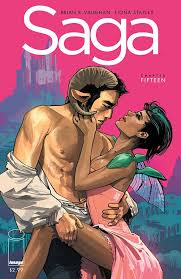 One of these months, Saga is going to slip up and deliver a monumental cock-up of an issue, and we’ll still be convinced it is part of the master plan. As close to monthly perfection as graphically possible, Vaughan starts things right with an indignant Countess Robot X accusing her underlings of being “overgrown condom failures”. While the central story is some downtime for the fleeing family, a second read of the issue reveals just how much is actually going on across the multiple storylines. Paparazzi Upsher and Doff seek the sensationalism behind the truth, while the local cuisine isn’t agreeing with The Will or his young ward. Vaughan’s skill is in giving us just enough of each to draw us in and keep us hooked for the next month, and the introduction of Countess Robot X is a potentially interesting new twist. Fiona Staples is the other 50% of the reason that you buy this book monthly, as we assume you all do, or you should stop reading this immediately and go and buy some copies. She creates three distinct tones for the main settings, and it’s fair to say there is a happier vibe to the art this issue. At least until things get a little stabby in the final panels. This, and the fourteeen issues that preceded it, is what we call a “must read” in the industry.
One of these months, Saga is going to slip up and deliver a monumental cock-up of an issue, and we’ll still be convinced it is part of the master plan. As close to monthly perfection as graphically possible, Vaughan starts things right with an indignant Countess Robot X accusing her underlings of being “overgrown condom failures”. While the central story is some downtime for the fleeing family, a second read of the issue reveals just how much is actually going on across the multiple storylines. Paparazzi Upsher and Doff seek the sensationalism behind the truth, while the local cuisine isn’t agreeing with The Will or his young ward. Vaughan’s skill is in giving us just enough of each to draw us in and keep us hooked for the next month, and the introduction of Countess Robot X is a potentially interesting new twist. Fiona Staples is the other 50% of the reason that you buy this book monthly, as we assume you all do, or you should stop reading this immediately and go and buy some copies. She creates three distinct tones for the main settings, and it’s fair to say there is a happier vibe to the art this issue. At least until things get a little stabby in the final panels. This, and the fourteeen issues that preceded it, is what we call a “must read” in the industry.
X-Men: Battle of the Atom #2 – Marvel, Jason Aaron (writer), Esad Ribic, Giuseppe Camuncoli, Andrew Curries, Tom Palmer, Ive Svorcina, Andres Mossa and Guru eFX (artists)
Rating: 6/10
 Battle of the Atom has been one of those strange little crossover events that has been fairly consistent with recent issues of X-Men, and while Jason Aaron is the principal writer on this issue, it’s very much still Brian Michael Bendis’s narrative baby. Despite interrupting the flow of some preexisting arcs, most notably the fledgling X-Men from Brian Wood, there’s been an internal consistency to to the story, a feat in itself for something that’s largely about time travel. As the three time-streams coalesce into an almighty fight between several Jean Greys, a stack of Icemen and enough Beasts to shag carpet your walls, it pretty much comes down to S.H.I.E.L.D. versus the X-Men, along with some X-Men versus some other X-Men. Given that is the spark that began this run of All-New X-Men over the last year or so, in the aftermath of Avengers Vs. X-Men, it’s an anti-climax but it’s still an ending. This particular ending will have consequences for the various teams, although 10 issues seems like a lot of work to return to a status quo with a roster change. The masses of names attached to the art department should scream “disaster”, but it’s more a matter of efficacy in what has effectively been a weekly series. Esad Ribic’s art is a standout, which includes the return of some powerful foes from an unexpected source. With more epilogues than the Return of the King, there’s plenty of scope for the All-New Marvel NOW! to branch out in 2014.
Battle of the Atom has been one of those strange little crossover events that has been fairly consistent with recent issues of X-Men, and while Jason Aaron is the principal writer on this issue, it’s very much still Brian Michael Bendis’s narrative baby. Despite interrupting the flow of some preexisting arcs, most notably the fledgling X-Men from Brian Wood, there’s been an internal consistency to to the story, a feat in itself for something that’s largely about time travel. As the three time-streams coalesce into an almighty fight between several Jean Greys, a stack of Icemen and enough Beasts to shag carpet your walls, it pretty much comes down to S.H.I.E.L.D. versus the X-Men, along with some X-Men versus some other X-Men. Given that is the spark that began this run of All-New X-Men over the last year or so, in the aftermath of Avengers Vs. X-Men, it’s an anti-climax but it’s still an ending. This particular ending will have consequences for the various teams, although 10 issues seems like a lot of work to return to a status quo with a roster change. The masses of names attached to the art department should scream “disaster”, but it’s more a matter of efficacy in what has effectively been a weekly series. Esad Ribic’s art is a standout, which includes the return of some powerful foes from an unexpected source. With more epilogues than the Return of the King, there’s plenty of scope for the All-New Marvel NOW! to branch out in 2014.
Agree or disagree? Got a comment? Start a conversation below, or take it with you on Behind the Panel’s Facebook and Twitter!
If you are an iTunes user, subscribe to our weekly podcast free here and please leave us feedback. That’s how we get more attention on the Interwebs!

